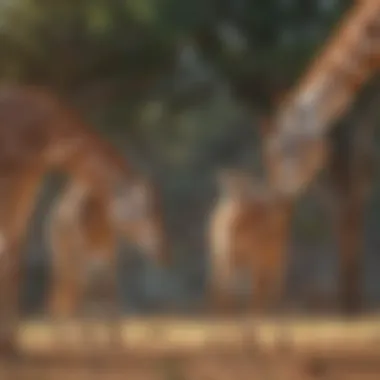The Fascinating Vocalizations of Giraffes Unveiled


Intro
Giraffes, often seen as serene giants roaming the savannah, reveal a complexity in their interactions that goes beyond their towering silhouettes. Many assume that these animals communicate solely through visual signals. However, recent studies show that they produce a variety of vocalizations that serve crucial roles in their social behavior. Understanding these sounds may deepen our appreciation of giraffes and enhance our knowledge of animal communication.
Animal Overview
Common Names
The giraffe is commonly recognized by several names, such as the southern giraffe and the northern giraffe. These names often reflect their specific geographical distributions or subspecies, each exhibiting unique characteristics.
Scientific Classification
The giraffe belongs to the family Giraffidae, with the scientific name Giraffa camelopardalis. This classification highlights its distinction as the tallest land animal and a member of a unique family.
Geographic Range
Giraffes inhabit a range of African ecosystems. Their presence spans multiple countries, including South Africa, Kenya, and Tanzania. Each sub-species favors different habitats, from savannahs to open woodlands, facilitating diverse interactions with their environment.
Behavior and Social Structure
Social Behavior
Giraffes are social animals. They often form loose herds, typically comprising females and their young, while males may join more transient groups. These social structures allow them to monitor one another and enhance their collective awareness of predators.
Communication
In terms of vocal communication, giraffes are often described as 'silent,' but this characterization is misleading. They emit low-frequency sounds, including grunts and moans, which can travel long distances. This is particularly useful in their natural habitats where visibility may be limited.
Foreword to Giraffe Communication
Understanding how giraffes communicate is essential. Their vocalizations represent under-explored behaviour that offers insights into their social lives. This not only increases our knowledge of giraffe behaviour, but it can also enhance conservation efforts. Recognizing giraffe sounds helps in identifying their moods and interactions within groups, proving that their communication is rich and nuanced despite the perception of them being largely silent.
Understanding Animal Communication
Animal communication includes various forms of signaling. Biologists typically focus on visual cues, body language, and sounds. Giraffe communication adds a layer of complexity to this study. Their vocalizations allow for social bonding and coordination among individuals. These sounds can indicate alarm, distress, or even social closeness. It’s crucial to note that these vocalizations can differ in frequency and pitch, serving specific purposes within different contexts.
The Giraffe’s Unique Anatomy
The anatomy of giraffes supports their method of communication. Giraffes possess long necks and a sophisticated larynx that enables them to produce a range of sounds. Their vocal cords are highly developed, which allows for both low and high-frequency vocalizations. Furthermore, their unique body structure affects how their sound travels in the wild. For instance, low-frequency sounds can travel farther, connecting individuals across vast distances in the savannah. This adaptation plays a key role in their social organization and interaction patterns.
“Understanding giraffe vocalizations can reveal much about their social structure and behaviors, making it a vital area of study.”
Types of Sounds Made by Giraffes
Understanding the types of sounds made by giraffes is crucial for recognizing their communication strategies and social structures. This section delves into the vocalizations of giraffes, categorizing them primarily into low-frequency vocalizations, high-frequency sounds, and non-vocal sounds. Each category plays a distinct role in how giraffes interact with one another and their environment.
Low Frequency Vocalizations


Low-frequency sounds are an important component of giraffe communication. These sounds are typically below 100 Hz and are produced infrequently. They can travel great distances, which is beneficial in the vast African savannah.
Usage in Social Interactions
In terms of usage in social interactions, low-frequency vocalizations help giraffes convey information across large spaces. These sounds may signal the presence of a nearby group or alert others to potential threats. The distinctive tone of these vocalizations aids in group identification. This characteristic makes them a popular choice for communication in a species that often spends time foraging away from one another. One unique feature of low-frequency calls is that they can be made while the individual is busy feeding, allowing for continuous communication without interrupting their activity.
Impact on Group Dynamics
The impact of low-frequency vocalizations on group dynamics cannot be overstated. These calls can establish a sense of cohesion among group members. They provide assurances that all members are aware of each other's whereabouts. The key characteristic here is that these sounds can strengthen social bonds, especially among mothers and their calves. However, while beneficial, reliance on such vocalizations can also become a disadvantage if groups become too dispersed, reducing the effectiveness of the communication.
High Frequency Sounds
High-frequency sounds are generally under 5 kHz and tend to be less understood in giraffe communication.
Contextual Significance
High-frequency sounds serve important contextual significance during specific interactions, such as during mating or when a calf is in distress. These sounds often include bleats that can attract attention quickly. The crucial characteristic of these sounds is their immediate effect in signaling urgency or necessity. Their short duration and sharp quality allow them to cut through environmental noise, enhancing their communicative power. This feature is particularly advantageous during high-stress situations, although it may not be as effective over long distances.
Influence on Young Giraffes
The influence of high-frequency sounds on young giraffes is particularly noteworthy. Young individuals often rely on these sounds to seek attention from their mothers and to communicate distress. The high-pitched nature of these vocalizations is a direct appeal for maternal care, crucial for survival in early life stages. One advantage of this reliance is that it fosters strong bonds between mothers and their young, essential for the calf's development. However, dependence on such calls can pose challenges if young giraffes do not learn to use low-frequency vocalizations as they mature, hampering their ability to integrate into broader social groups.
Non-vocal Sounds
Non-vocal sounds also contribute significantly to giraffe communication. These are often overlooked but hold critical meanings in their social interactions.
Body Language as Communication
Body language is an integral part of how giraffes communicate without sound. This involves their posture, movements, and even the movement of their necks. A giraffe’s body stance can indicate aggression or submission, while subtle movements can express curiosity or anxiety. The key characteristic of body language is its immediacy; it provides instant feedback to others, enhancing social interactions. While advantageous in conveying messages quickly, its interpretation can be subjective, leading to potential misunderstandings among individuals.
Other Types of Non-verbal Signals
Other types of non-verbal signals include olfactory cues, such as scent marking, and visual displays, like licking or grooming. These signals can convey much about a giraffe’s health, reproductive status, or even stress levels. The unique feature of these signals is their sustainability; they provide prolonged engagement with other giraffes. This feature enhances long-term social bonds. However, the complexity of non-verbal cues can lead to ambiguity, particularly for outsiders or new members in a social group.
The Role of Vocalizations in Social Structure
Vocalizations are vital for understanding the social structure of giraffes. While many assume these animals are largely quiet, their vocal sounds are crucial in establishing and maintaining social bonds within their herds. This aspect of giraffe communication sheds light on their interactions and relationships, which often influence their survival and well-being.
Hierarchy and Communication
In the world of wildlife, establishing hierarchy is fundamental. For giraffes, vocalizations convey subtle social signals that indicate ranks and roles within a group. Low-frequency vocalizations can often reflect a dominant presence. These sounds are used to assert authority and may deter others from challenging a giraffe's position. In addition to audible signals, giraffes also rely on body language to reinforce their status. Researchers have noted that when lower-ranked giraffes vocalize, they may do so more cautiously, revealing their understanding of the social dynamics at play.
Such communication is not merely for display. It is a method of information relay among group members, assisting them in navigating complex social structures. Giraffes often use these low-frequency calls to coordinate movements during foraging or evading predators. Understanding the vocalizations’ role in hierarchy provides a window into their sophisticated social life, emphasizing that these animals are not just solitary beings but rather part of intricate community interactions.
Mother-Calf Interactions
Mother-calf relationships in giraffes are particularly special. Vocalizations are vital during the early stages of a calf's life. A mother giraffe uses soft, low-pitched sounds to communicate with her young. These sounds are soothing and help the calf feel secure. Interestingly, calves also produce their own range of vocalizations to signal their needs, such as when they are hungry or uncomfortable.


This form of communication fosters a strong bond between mother and calf. It allows the mother to respond promptly to her calf's needs, which is essential for the calf's development and survival. As the young grow, their vocalizations change, reflecting their growth and increased confidence within the herd's social structure. Understanding these intricate communications not only enriches our knowledge of giraffe social behavior but also underscores the significance of vocalizations in nurturing relationships within these animals.
The intricate sounds giraffes make are more than mere noises; they are essential for nurturing relationships and establishing social order.
In summary, giraffe vocalizations play a critical role in the social structure of their species. These sounds help establish hierarchy and facilitate mother-calf interactions, showing the depth of their communication. Recognizing this allows for a greater appreciation of giraffes beyond their physical appearance, highlighting their complex social lives.
Situational Contexts of Giraffe Sounds
The situational contexts of giraffe sounds hold significant importance in understanding their communication. Recognizing what triggers certain vocalizations can give insights into their behavior and social dynamics. Giraffes, while often thought to be quiet, utilize their vocal abilities in various situations. Analyzing these contexts enhances our comprehension of their interactions, revealing the complexities of their communication.
Vocalizations During Mating Season
During mating season, giraffes display a distinctive range of vocalizations. Males often produce sounds to attract females and assert dominance over competing males. The competition among males can lead to a variety of vocal signals. These sounds vary in tone and duration, signifying different intentions. Males may use low-frequency calls that are not easily detected by humans, suggesting a tactical advantage in establishing their presence without alarming predators.
The vocal behavior of females also changes during this period. They may respond to male sounds, indicating receptiveness or disinterest. Communication during mating is crucial for reproductive success. It allows for the mutual recognition of potential mates and reinforces social structures within groups. Understanding these vocalizations can provide significant information about giraffe reproductive strategies and the implications for population dynamics.
Communication During Threats
Giraffes use vocalizations as a means of expressing alarm and coordinating responses during threatening situations. When a predator approaches, giraffes may produce sharp, high-pitched calls. These sounds alert others in the vicinity, creating a unified response. Such coordination is essential for survival, particularly when in groups. The use of vocalizations allows for quick communication of danger, enabling efficient evasion strategies.
In addition to vocal alarms, body language also plays a significant role. Giraffes may combine vocal signals with physical signals, such as raised necks or pacing. These actions reinforce the urgency or severity of the threat. Understanding these dynamics enhances our knowledge of giraffe social behavior, their awareness of environmental dangers, and their adaptive strategies.
The way giraffes vocalize in different situations highlights their complex social interactions.
Some key points include:
- Vocalizations during mating involve attracting mates and establishing dominance.
- Alarm calls are crucial for group safety during predator encounters.
- Body language complements sound, providing a fuller context for understanding giraffe communication.
In summary, the situational contexts of giraffe sounds reveal much about their social structure and behavior. Both mating and threat situations elicit specific vocalizations that carry different meanings, emphasizing the importance of context in their communication.
Research Methodologies for Studying Giraffe Sounds
Understanding how giraffes communicate through vocalizations is essential. The methodologies employed to study these sounds are a foundation for any conclusions drawn about giraffe behavior. This section emphasizes the importance of research methodologies, detailing specific techniques and their implications.
Acoustic Monitoring Techniques
Acoustic monitoring is a crucial tool in studying the vocalizations made by giraffes. This method allows researchers to capture and analyze sounds in their natural habitat. The use of specialized recording devices enables the detection of low-frequency sounds that might otherwise go unnoticed by the human ear.
Importance of This Technique
By employing acoustic monitoring, researchers can gather a wealth of data on giraffe vocalizations without causing disturbance to their natural behavior. This non-invasive approach contributes to more accurate observations. It can also capture sounds associated with various activities, such as mating or communication during threat.
Key Benefits
- Continuous Data Collection: Researchers can record sounds over extended periods, allowing them to observe patterns and variations.
- Contextual Understanding: By correlating sounds with specific behaviors or events, insights into the function of each vocalization can be obtained.
- Low Intrusiveness: Animals behave more naturally when they are not directly observed, minimizing the impact of human presence on their behavior.
In summary, acoustic monitoring is vital for a thorough understanding of giraffe sounds. This method not only enhances data accuracy but also enriches the overall research environment.


Field Observations and Behavior Analysis
Field observations are another fundamental methodology for studying giraffe vocalizations. This approach involves observing giraffe groups in their habitats and documenting vocal behaviors in real-time. It complements acoustic monitoring by providing context to the sounds produced.
Importance of Observational Studies
Field observations offer critical insights into how giraffes use vocalizations within their social structure. By analyzing interactions between individual giraffes, researchers can identify how sounds influence group dynamics. This observational method highlights not only the sounds but also the associated visual behaviors communication.
Considerations for Field Studies
- Time of Day: Sounds may vary based on the time of day or social context. Observations should consider these factors.
- Setting and Environment: Giraffes may change their vocalizations based on environmental stressors. Gathering data in various settings can lead to more comprehensive findings.
- Behavioral Context: It is key to note the specific scenarios when sounds are made, as this directly links vocalizations to social interactions.
Field observations and behavior analysis are invaluable methods. They enrich the understanding of giraffe vocalizations by providing context and depth to the recorded sounds. These methodologies work together for a more complete view of giraffe communication.
Implications of Understanding Giraffe Sounds
Understanding the vocalizations of giraffes holds significant value, both for conservation and for enhancing their quality of life in various settings. These sounds are not merely incidental; they provide insight into the social structures and emotional states of these unique animals. By decoding what their sounds mean, we can apply that knowledge to multiple domains, including conservation practices and the betterment of zoo environments. Recognizing how giraffes communicate can help us understand their needs and behaviors more deeply.
Conservation Efforts
Awareness of giraffe communication can directly influence conservation strategies. Giraffes are facing various threats, including habitat loss and poaching. Understanding how they communicate can help in these ways:
- Identifying Critical Habitats: Vocalizations can indicate areas where giraffes are more likely to gather. By studying their sounds, conservationists can focus on protecting these vital environments.
- Monitoring Populations: Acoustic monitoring tools can be employed to track giraffe populations in remote areas. By understanding their communication, researchers can better manage and protect these populations over time.
- Reducing Human-Giraffe Conflicts: Awareness of giraffe vocalizations may help locals understand when giraffes are in distress or nearing agricultural areas. This understanding can reduce potential conflicts between humans and giraffes.
By employing data from vocalization studies, we can form a well-rounded approach to giraffe conservation that respects their natural behaviors and habitats.
Enhancing Zoo Environments
Zoos play a critical role in educating the public and protecting endangered species. Understanding giraffe sounds can substantially improve their care in captivity:
- Behavioral Enrichment: By mimicking the natural vocalizations of giraffes or creating environments that stimulate such sounds, zookeepers can enhance mental stimulation and reduce stress among captive giraffes.
- Improved Animal Care: Understanding vocalizations also aids in timing medical interventions and improving health care routines. For example, observing changes in vocal patterns may indicate health issues that need immediate attention.
- Educational Programs: Insights into giraffe communication can enrich educational programs for zoo visitors. Sharing knowledge about how giraffes communicate can foster a greater appreciation for these animals and underscore the importance of conservation.
Understanding the soundscapes of giraffes informs both conservation efforts and captive care, ultimately leading to better outcomes for these majestic creatures.
In summary, recognizing the implications of giraffe vocalizations extends beyond mere academic interest. It shapes conservation strategies and enhances the quality of life in zoos, linking scientific understanding to practical applications. As we deepen our comprehension of giraffe sounds, we foster better environments for them, whether in the wild or in human care.
Epilogue
Understanding the vocalizations of giraffes is crucial for appreciating their complex behavior and social dynamics. Their sounds, previously underestimated, serve multiple roles in communication, indicating social hierarchies, mating rituals, and responses to threats. Not only does this knowledge enhance our comprehension of giraffes, but it also underscores the need for conservation initiatives that protect their habitats.
Summary of Findings
Through our exploration, we illuminate various aspects of giraffe communication. Key findings include:
- Giraffes utilize both low and high-frequency sounds to convey messages.
- Vocalizations play a significant role in mother-calf bonding, aiding survival in early development.
- The lack of research on giraffe sounds highlights gaps in our understanding, necessitating more extensive studies.
This insight enhances our awareness of how vocalizations impact giraffe interactions and social structures.
Future Directions for Research
Future research should focus on several areas to deepen our understanding of giraffe vocalizations:
- Acoustic Analysis: More comprehensive studies using advanced acoustic monitoring technology can reveal the nuances in their sounds.
- Behavioral Studies: Observing giraffes in various social contexts will provide insights into when and why specific sounds are made.
- Comparative Studies: Investigating vocalizations in relation to other species could yield interesting parallels and divergences in communication.
- Conservation Implications: Understanding how sounds affect group dynamics can inform conservation strategies, particularly in fragmented habitats.
Giraffes are fascinating creatures, and understanding their vocalizations is essential for fostering a deeper appreciation of them and aiding their conservation.







